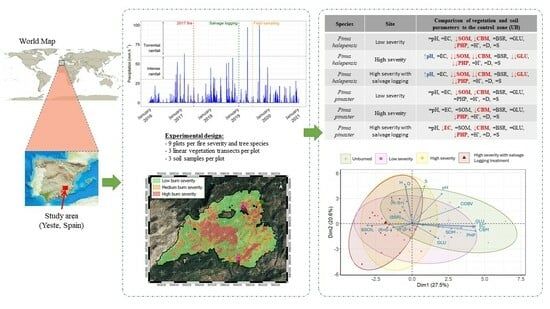Burn Severity and Postfire Salvage Logging Effects on Vegetation and Soil System in a Short-Term Period in Mediterranean Pine Forests
Abstract
:1. Introduction
- (i)
- Evaluating the effects of burn severity and the immediate impacts of postfire salvage logging interventions on soil system properties in the designated stands: Pinus halepensis Mill and Pinus pinaster Aiton;
- (ii)
- Examining vegetation population dynamics by considering two pine stands in the fire-affected perimeter. This analysis assessed the dominant tree species alongside the associated thermo-Mediterranean shrub vegetation.
2. Materials and Methods
2.1. Study Area
- (1)
- High-severity plots with no intervention;
- (2)
- High-severity plots with salvage logging treatment;
- (3)
- Low-severity plots with no intervention;
- (4)
- Unburned areas with no intervention at all.
2.2. Experimental Design
2.3. Soil System Properties
2.4. Vegetation Index Calculations
2.5. Statistical Analyses
3. Results
3.1. Soil System Properties Analyses
3.2. Vegetation Index Analyses
3.3. Plant–Soil Interactions
4. Discussion
4.1. Effects of Wildfire and Salvage Logging on Soil Properties
4.2. Effects of Wildfire and Salvage Logging on Vegetation Indices
4.3. Effects of Wildfire and Salvage Logging on Plant–Soil Interactions
5. Conclusions
Supplementary Materials
Author Contributions
Funding
Data Availability Statement
Acknowledgments
Conflicts of Interest
References
- Pausas, J.G.; Llovet, J.; Rodrigo, A.; Vallejo, R.; Pausas, J.G.; Llovet, J.; Rodrigo, A.; Vallejo, R. Are Wildfires a Disaster in the Mediterranean Basin?—A Review. Int. J. Wildland Fire 2009, 17, 713–723. [Google Scholar] [CrossRef]
- Bowman, D.M.J.S.; Kolden, C.A.; Abatzoglou, J.T.; Johnston, F.H.; van der Werf, G.R.; Flannigan, M. Vegetation Fires in the Anthropocene. Nat. Rev. Earth Environ. 2020, 1, 500–515. [Google Scholar] [CrossRef]
- San-Miguel-Ayanz, J.; Durrant, T.; Boca, R.; Maianti, P.; Liberta’, G.; Oom, D.; Branco, A.; De, R.D.; Ferrari, D.; Roglia, E.; et al. Advance Report on Forest Fires in Europe, Middle East and North Africa 2022. Available online: https://publications.jrc.ec.europa.eu/repository/handle/JRC133215 (accessed on 21 June 2023).
- Geary, W.L.; Buchan, A.; Allen, T.; Attard, D.; Bruce, M.J.; Collins, L.; Ecker, T.E.; Fairman, T.A.; Hollings, T.; Loeffler, E.; et al. Responding to the Biodiversity Impacts of a Megafire: A Case Study from South-Eastern Australia’s Black Summer. Divers. Distrib. 2022, 28, 463–478. [Google Scholar] [CrossRef]
- Xu, R.; Yu, P.; Abramson, M.J.; Johnston, F.H.; Samet, J.M.; Bell, M.L.; Haines, A.; Ebi, K.L.; Li, S.; Guo, Y. Wildfires, Global Climate Change, and Human Health. N. Engl. J. Med. 2020, 383, 2173–2181. [Google Scholar] [CrossRef] [PubMed]
- Ruffault, J.; Curt, T.; Moron, V.; Trigo, R.M.; Mouillot, F.; Koutsias, N.; Pimont, F.; Martin-StPaul, N.; Barbero, R.; Dupuy, J.-L.; et al. Increased Likelihood of Heat-Induced Large Wildfires in the Mediterranean Basin. Sci. Rep. 2020, 10, 13790. [Google Scholar] [CrossRef] [PubMed]
- Ellis, T.M.; Bowman, D.M.J.S.; Jain, P.; Flannigan, M.D.; Williamson, G.J. Global Increase in Wildfire Risk Due to Climate-Driven Declines in Fuel Moisture. Glob. Chang. Biol. 2022, 28, 1544–1559. [Google Scholar] [CrossRef]
- Alcasena, F.J.; Ager, A.A.; Bailey, J.D.; Pineda, N.; Vega-García, C. Towards a Comprehensive Wildfire Management Strategy for Mediterranean Areas: Framework Development and Implementation in Catalonia, Spain. J. Environ. Manag. 2019, 231, 303–320. [Google Scholar] [CrossRef]
- Duane, A.; Castellnou, M.; Brotons, L. Towards a Comprehensive Look at Global Drivers of Novel Extreme Wildfire Events. Clim. Chang. 2021, 165, 43. [Google Scholar] [CrossRef]
- Turco, M.; Llasat, M.-C.; von Hardenberg, J.; Provenzale, A. Climate Change Impacts on Wildfires in a Mediterranean Environment. Clim. Chang. 2014, 125, 369–380. [Google Scholar] [CrossRef]
- Vallejo, V.R.; Arianoutsou, M.; Moreira, F. Fire Ecology and Post-Fire Restoration Approaches in Southern European Forest Types. In Post-Fire Management and Restoration of Southern European Forests; Moreira, F., Arianoutsou, M., Corona, P., de las Heras, J., Eds.; Managing Forest Ecosystems; Springer: Dordrecht, The Netherlands, 2012; pp. 93–119. ISBN 978-94-007-2208-8. [Google Scholar]
- Newton, A.C.; Cantarello, E. Restoration of Forest Resilience: An Achievable Goal? New For. 2015, 46, 645–668. [Google Scholar] [CrossRef]
- O’Donnell, F.C.; Flatley, W.T.; Springer, A.E.; Fulé, P.Z. Forest Restoration as a Strategy to Mitigate Climate Impacts on Wildfire, Vegetation, and Water in Semiarid Forests. Ecol. Appl. 2018, 28, 1459–1472. [Google Scholar] [CrossRef] [PubMed]
- Alayan, R.; Rotich, B.; Lakner, Z. A Comprehensive Framework for Forest Restoration after Forest Fires in Theory and Practice: A Systematic Review. Forests 2022, 13, 1354. [Google Scholar] [CrossRef]
- Arianoutsou, M.; Ne’eman, G. Post-Fire Regeneration of Natural Pinus halepensis Forests in the East Mediterranean Basin. In Ecology, Biogeography and Management of Pinus halepensis and P. brutia Forest Ecosystems in the Mediterranean Basin; Backhuys Publishers: Leiden, The Netherlands, 2000; pp. 269–290. [Google Scholar]
- De las Heras, J.; Moya, D.; Vega, J.A.; Daskalakou, E.; Vallejo, V.R.; Grigoriadis, N.; Tsitsoni, T.; Baeza, J.; Valdecantos, A.; Fernández, C.; et al. Post-Fire Management of Serotinous Pine Forests. In Post-Fire Management and Restoration of Southern European Forests; Moreira, F., Arianoutsou, M., Corona, P., de las Heras, J., Eds.; Managing Forest Ecosystems; Springer: Dordrecht, The Netherlands, 2012; pp. 121–150. ISBN 978-94-007-2208-8. [Google Scholar]
- Fernández-García, V.; Fulé, P.Z.; Marcos, E.; Calvo, L. The Role of Fire Frequency and Severity on the Regeneration of Mediterranean Serotinous Pines under Different Environmental Conditions. For. Ecol. Manag. 2019, 444, 59–68. [Google Scholar] [CrossRef]
- Rodríguez-García, E.; Santana, V.M.; Alloza, J.A.; Ramón Vallejo, V. Predicting Natural Hyperdense Regeneration after Wildfires in Pinus halepensis (Mill.) Forests Using Prefire Site Factors, Forest Structure and Fire Severity. For. Ecol. Manag. 2022, 512, 120164. [Google Scholar] [CrossRef]
- Keeley, J.E. Fire Intensity, Fire Severity and Burn Severity: A Brief Review and Suggested Usage. Int. J. Wildland Fire 2009, 18, 11. [Google Scholar] [CrossRef]
- Key, C.H.; Benson, N.C. Landscape Assessment: Ground measure of severity, the Composite Burn Index; and Remote sensing of severity, the Normalized Burn Ratio. In FIREMON: Fire Effects Monitoring and Inventory System; USDA Forest Service, Rocky Mountain Research Station: Ogden, UT, USA, 2006. [Google Scholar]
- Lutes, D.C.; Keane, R.E.; Caratti, J.F.; Key, C.H.; Benson, N.C.; Sutherland, S.; Gangi, L.J. FIREMON: Fire Effects Monitoring and Inventory System. In General Technical Report RMRS-GTR-164-CD; U.S. Department of Agriculture, Forest Service, Rocky Mountain Research Station. 1 CD: Fort Collins, CO, USA, 2006; p. 164. [Google Scholar] [CrossRef]
- Moya, D.; González-De Vega, S.; Lozano, E.; García-Orenes, F.; Mataix-Solera, J.; Lucas-Borja, M.E.; de las Heras, J. The Burn Severity and Plant Recovery Relationship Affect the Biological and Chemical Soil Properties of Pinus halepensis Mill. Stands in the Short and Mid-Terms after Wildfire. J. Environ. Manag. 2019, 235, 250–256. [Google Scholar] [CrossRef] [PubMed]
- Agbeshie, A.A.; Abugre, S.; Atta-Darkwa, T.; Awuah, R. A Review of the Effects of Forest Fire on Soil Properties. J. For. Res. 2022, 33, 1419–1441. [Google Scholar] [CrossRef]
- Girona-García, A.; Vieira, D.C.S.; Silva, J.; Fernández, C.; Robichaud, P.R.; Keizer, J.J. Effectiveness of Post-Fire Soil Erosion Mitigation Treatments: A Systematic Review and Meta-Analysis. Earth-Sci. Rev. 2021, 217, 103611. [Google Scholar] [CrossRef]
- López-Vicente, M.; Cerdà, A.; Kramer, H.; Keesstra, S. Post-Fire Practices Benefits on Vegetation Recovery and Soil Conservation in a Mediterranean Area. Land. Use Policy 2021, 111, 105776. [Google Scholar] [CrossRef]
- Gómez-Sánchez, E.; de las Heras, J.; Lucas-Borja, M.; Moya, D. Assessing fire severity in semi-arid environments: Application in Donceles 2012 wildfire (SE Spain). Rev. Teledetección 2017, 103–113. [Google Scholar] [CrossRef]
- Gómez Sánchez, M.E.; Lucas Borja, M.E.; Plaza Álvarez, P.A.; González Romero, J.; Sagra Cozar, J.; Moya Navarro, D.; de las Heras Ibáñez, J. Efecto de los trabajos de restauración forestal post-incendio en ladera sobre la recuperación de la funcionalidad del suelo. Cuad. Soc. Española Cienc. For. 2019, 45, 35–44. [Google Scholar] [CrossRef]
- Donato, D.C.; Fontaine, J.B.; Campbell, J.L.; Robinson, W.D.; Kauffman, J.B.; Law, B.E. Post-Wildfire Logging Hinders Regeneration and Increases Fire Risk. Science 2006, 311, 352. [Google Scholar] [CrossRef]
- Heil, L.J.; Burkle, L.A. The Effects of Post-Wildfire Salvage Logging on Plant Reproductive Success and Pollination in Symphoricarpos Albus, a Fire-Tolerant Shrub. For. Ecol. Manag. 2019, 432, 157–163. [Google Scholar] [CrossRef]
- Povak, N.A.; Churchill, D.J.; Cansler, C.A.; Hessburg, P.F.; Kane, V.R.; Kane, J.T.; Lutz, J.A.; Larson, A.J. Wildfire Severity and Postfire Salvage Harvest Effects on Long-Term Forest Regeneration. Ecosphere 2020, 11, e03199. [Google Scholar] [CrossRef]
- García-Carmona, M.; García-Orenes, F.; Mataix-Solera, J.; Roldán, A.; Pereg, L.; Caravaca, F. Salvage Logging Alters Microbial Community Structure and Functioning after a Wildfire in a Mediterranean Forest. Appl. Soil. Ecol. 2021, 168, 104130. [Google Scholar] [CrossRef]
- Leverkus, A.B.; Buma, B.; Wagenbrenner, J.; Burton, P.J.; Lingua, E.; Marzano, R.; Thorn, S. Tamm Review: Does Salvage Logging Mitigate Subsequent Forest Disturbances? For. Ecol. Manag. 2021, 481, 118721. [Google Scholar] [CrossRef]
- Mantero, G.; Morresi, D.; Negri, S.; Anselmetto, N.; Lingua, E.; Bonifacio, E.; Garbarino, M.; Marzano, R. Short-Term Drivers of Post-Fire Forest Regeneration in the Western Alps. Fire Ecol. 2023, 19, 23. [Google Scholar] [CrossRef]
- Müller, J.; Noss, R.F.; Thorn, S.; Bässler, C.; Leverkus, A.B.; Lindenmayer, D. Increasing Disturbance Demands New Policies to Conserve Intact Forest. Conserv. Lett. 2019, 12, e12449. [Google Scholar] [CrossRef]
- Leverkus, A.B.; Gustafsson, L.; Lindenmayer, D.B.; Castro, J.; Rey Benayas, J.M.; Ranius, T.; Thorn, S. Salvage Logging Effects on Regulating Ecosystem Services and Fuel Loads. Front. Ecol. Environ. 2020, 18, 391–400. [Google Scholar] [CrossRef]
- Leverkus, A.B.; Lorite, J.; Navarro, F.B.; Sánchez-Cañete, E.P.; Castro, J. Post-Fire Salvage Logging Alters Species Composition and Reduces Cover, Richness, and Diversity in Mediterranean Plant Communities. J. Environ. Manag. 2014, 133, 323–331. [Google Scholar] [CrossRef]
- Leverkus, A.B.; Gustafsson, L.; Rey Benayas, J.M.; Castro, J. Does Post-Disturbance Salvage Logging Affect the Provision of Ecosystem Services? A Systematic Review Protocol. Environ. Evid. 2015, 4, 16. [Google Scholar] [CrossRef]
- Lucas-Borja, M.E.; Plaza-Álvarez, P.A.; González-Romero, J.; Miralles, I.; Sagra, J.; Molina-Peña, E.; Moya, D.; de las Heras, J.; Fernández, C. Post-Wildfire Straw Mulching and Salvage Logging Affects Initial Pine Seedling Density and Growth in Two Mediterranean Contrasting Climatic Areas in Spain. For. Ecol. Manag. 2020, 474, 118363. [Google Scholar] [CrossRef]
- De Santis, A.; Chuvieco, E. GeoCBI: A Modified Version of the Composite Burn Index for the Initial Assessment of the Short-Term Burn Severity from Remotely Sensed Data. Remote Sens. Environ. 2009, 113, 554–562. [Google Scholar] [CrossRef]
- Viedma, O.; Chico, F.; Fernández, J.J.; Madrigal, C.; Safford, H.D.; Moreno, J.M. Disentangling the Role of Prefire Vegetation vs. Burning Conditions on Fire Severity in a Large Forest Fire in SE Spain. Remote Sens. Environ. 2020, 247, 111891. [Google Scholar] [CrossRef]
- Kottek, M.; Grieser, J.; Beck, C.; Rudolf, B.; Rubel, F. World Map of the Köppen-Geiger Climate Classification Updated. Meteorol. Z. 2006, 15, 259–263. [Google Scholar] [CrossRef] [PubMed]
- SIGA. Available online: https://sig.mapama.gob.es/siga/ (accessed on 30 November 2022).
- Soil Survey Staff. Keys to Soil Taxonomy, 13th ed.; USDA-Natural Resources Conservation Service: Washington, DC, USA, 2022. [Google Scholar]
- AEMET Weather Data from Yeste Station (Albacete-Spain) 2016–2021 State Meteorological Agency of Spanish Government (AEMET), Madrid, Spain. Available online: https://datosclima.es/Aemet2013/Precipitastad2013.php (accessed on 20 February 2024).
- Moya, D.; Certini, G.; Fulé, P.Z.; Moya, D.; Certini, G.; Fulé, P.Z. Fire Regime and Ecosystem Responses: Adaptive Forest Management in a Changing World (Part 2). Int. J. Wildland Fire 2019, 28, 471–472. [Google Scholar] [CrossRef]
- Jiménez-Morillo, N.T.; Almendros, G.; de la Rosa, J.M.; Jordán, A.; Zavala, L.M.; Granged, A.J.P.; González-Pérez, J.A. Effect of a Wildfire and of Post-Fire Restoration Actions in the Organic Matter Structure in Soil Fractions. Sci. Total Environ. 2020, 728, 138715. [Google Scholar] [CrossRef]
- Mataix-Solera, J.; Guerrero, C.; García-Orenes, F.; Bárcenas, G.M.; Torres, M.P. Forest Fire Effects on Soil Microbiology. In Fire Effects on Soils and Restoration Strategies; CRC Press: Boca Raton, FL, USA, 2009; pp. 149–192. [Google Scholar]
- Moya, D.; González-De Vega, S.; García-Orenes, F.; Morugán-Coronado, A.; Arcenegui, V.; Mataix-Solera, J.; Lucas-Borja, M.E.; de las Heras, J. Temporal Characterisation of Soil-Plant Natural Recovery Related to Fire Severity in Burned Pinus halepensis Mill. Forests. Sci. Total Environ. 2018, 640–641, 42–51. [Google Scholar] [CrossRef]
- Anderson, J.P.E.; Domsch, K.H. A Physiological Method for the Quantitative Measurement of Microbial Biomass in Soils. Soil. Biol. Biochem. 1978, 10, 215–221. [Google Scholar] [CrossRef]
- Shannon, C.E. A Mathematical Theory of Communication. Bell Syst. Tech. J. 1948, 27, 379–423. [Google Scholar] [CrossRef]
- Simpson, E.H. Measurement of Diversity. Nature 1949, 163, 688. [Google Scholar] [CrossRef]
- Canfield, R. Application of the Line Interception Method in Sampling Range Vegetation. J. For. 1941, 39, 388–394. [Google Scholar]
- van der Maarel, E. Transformation of Cover-Abundance Values for Appropriate Numerical Treatment-Alternatives to the Proposals by Podani. J. Veg. Sci. 2007, 18, 767–770. [Google Scholar] [CrossRef]
- Paula, S.; Arianoutsou, M.; Kazanis, D.; Tavsanoglu, Ç.; Lloret, F.; Buhk, C.; Ojeda, F.; Luna, B.; Moreno, J.M.; Rodrigo, A.; et al. Fire-Related Traits for Plant Species of the Mediterranean Basin. Ecology 2009, 90, 1420. [Google Scholar] [CrossRef]
- Posit Team. RStudio: Integrated Development Environment for R. Posit Software, PBC, Boston, MA. Available online: http://www.posit.co/2024 (accessed on 31 January 2024).
- Wickham, H.; François, R.; Henry, L.; Müller, K.; Vaughan, D. Dplyr: A Grammar of Data Manipulation, R package version 1.1.4; Posit Software, PBC: Boston, MA, USA, 2023. [Google Scholar]
- Wickham, H. Ggplot2; Use R! Springer International Publishing: Cham, Switzerland, 2016; ISBN 978-3-319-24275-0. [Google Scholar]
- Lucas-Borja, M.E.; Ortega, R.; Miralles, I.; Plaza-Álvarez, P.A.; González-Romero, J.; Peña-Molina, E.; Moya, D.; Zema, D.A.; Wagenbrenner, J.W.; de las Heras, J. Effects of Wildfire and Logging on Soil Functionality in the Short-Term in Pinus halepensis M. Forests. Eur. J. For. Res. 2020, 139, 935–945. [Google Scholar] [CrossRef]
- Muñoz-Rojas, M.; Erickson, T.E.; Martini, D.; Dixon, K.W.; Merritt, D.J. Soil Physicochemical and Microbiological Indicators of Short, Medium and Long Term Post-Fire Recovery in Semi-Arid Ecosystems. Ecol. Indic. 2016, 63, 14–22. [Google Scholar] [CrossRef]
- Erdozain, M.; Bonet, J.A.; Martínez de Aragón, J.; de-Miguel, S. Forest Thinning and Climate Interactions Driving Early-Stage Regeneration Dynamics of Maritime Pine in Mediterranean Areas. For. Ecol. Manag. 2023, 539, 121036. [Google Scholar] [CrossRef]
- Ribeiro, S.; Cerveira, A.; Soares, P.; Fonseca, T. Natural Regeneration of Maritime Pine: A Review of the Influencing Factors and Proposals for Management. Forests 2022, 13, 386. [Google Scholar] [CrossRef]
- Verkaik, I.; Espelta, J.M. Post-Fire Regeneration Thinning, Cone Production, Serotiny and Regeneration Age in Pinus halepensis. For. Ecol. Manag. 2006, 231, 155–163. [Google Scholar] [CrossRef]
- Moya, D.; Sagra, J.; Lucas-Borja, M.E.; Plaza-Álvarez, P.A.; González-Romero, J.; de Las Heras, J.; Ferrandis, P. Post-Fire Recovery of Vegetation and Diversity Patterns in Semiarid Pinus halepensis Mill. Habitats after Salvage Logging. Forests 2020, 11, 1345. [Google Scholar] [CrossRef]
- Keeley, J.E.; Pausas, J.G. Evolutionary Ecology of Fire. Annu. Rev. Ecol. Evol. Syst. 2022, 53, 203–225. [Google Scholar] [CrossRef]
- Cruz, O.; García-Duro, J.; Casal, M.; Reyes, O. Role of Serotiny on Pinus Pinaster Aiton Germination and Its Relation to Mother Plant Age and Fire Severity. iForest-Biogeosci. For. 2019, 12, 491. [Google Scholar] [CrossRef]
- Romero, B.; Ganteaume, A. Does Recent Fire Activity Impact Fire-Related Traits of Pinus halepensis Mill. and Pinus sylvestris L. in the French Mediterranean Area? Ann. For. Sci. 2020, 77, 106. [Google Scholar] [CrossRef]
- Castro, J.; Allen, C.D.; Molina-Morales, M.; Marañón-Jiménez, S.; Sánchez-Miranda, Á.; Zamora, R. Salvage Logging Versus the Use of Burnt Wood as a Nurse Object to Promote Post-Fire Tree Seedling Establishment. Restor. Ecol. 2011, 19, 537–544. [Google Scholar] [CrossRef]
- Panico, S.C.; Memoli, V.; Santorufo, L.; Aiello, S.; Barile, R.; de Marco, A.; Maisto, G. Soil Biological Responses under Different Vegetation Types in Mediterranean Area. Int. J. Environ. Res. Public Health 2022, 19, 903. [Google Scholar] [CrossRef]
- Fernández-García, V.; Miesel, J.; Baeza, M.J.; Marcos, E.; Calvo, L. Wildfire Effects on Soil Properties in Fire-Prone Pine Ecosystems: Indicators of Burn Severity Legacy over the Medium Term after Fire. Appl. Soil. Ecol. 2019, 135, 147–156. [Google Scholar] [CrossRef]

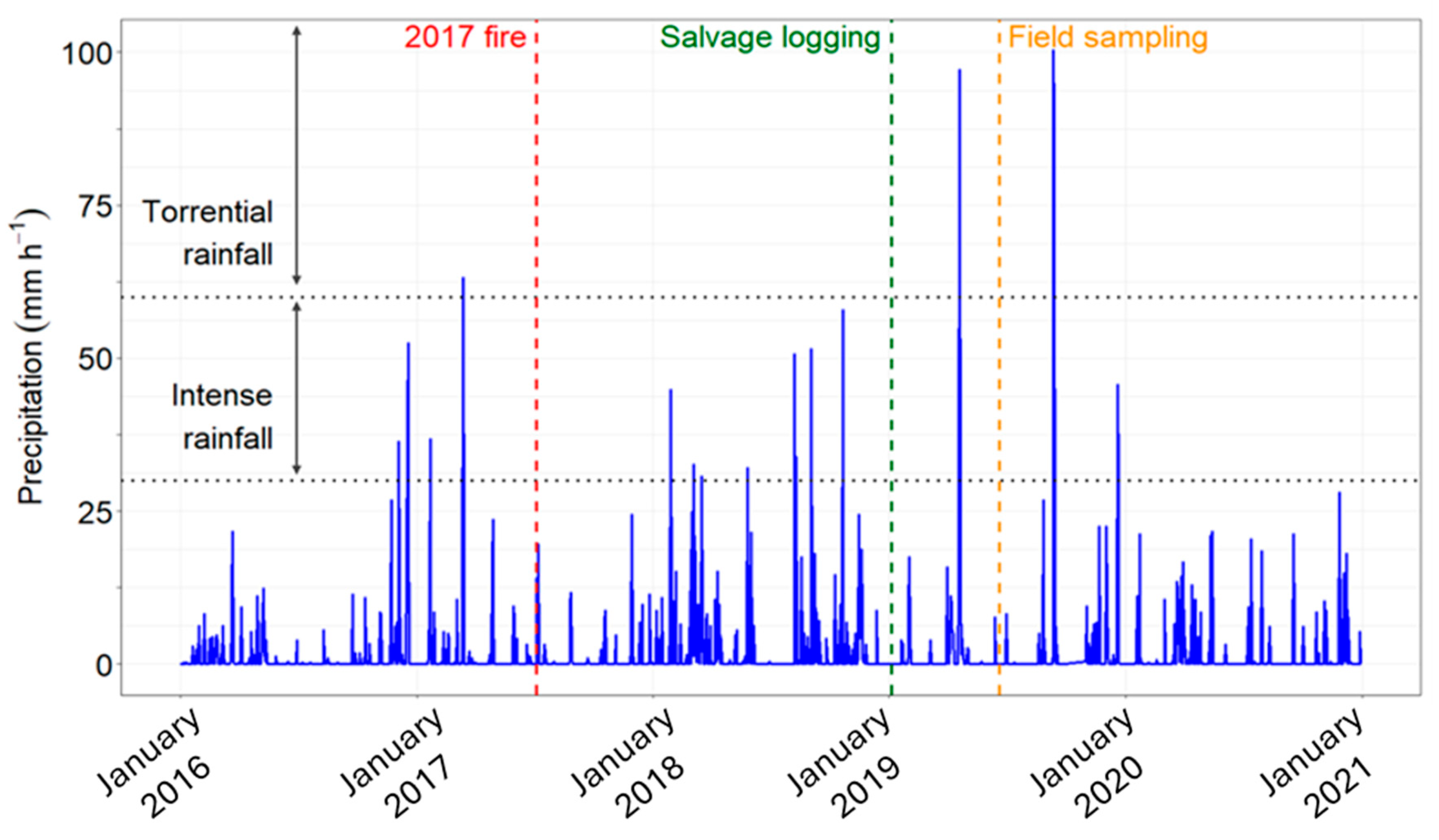
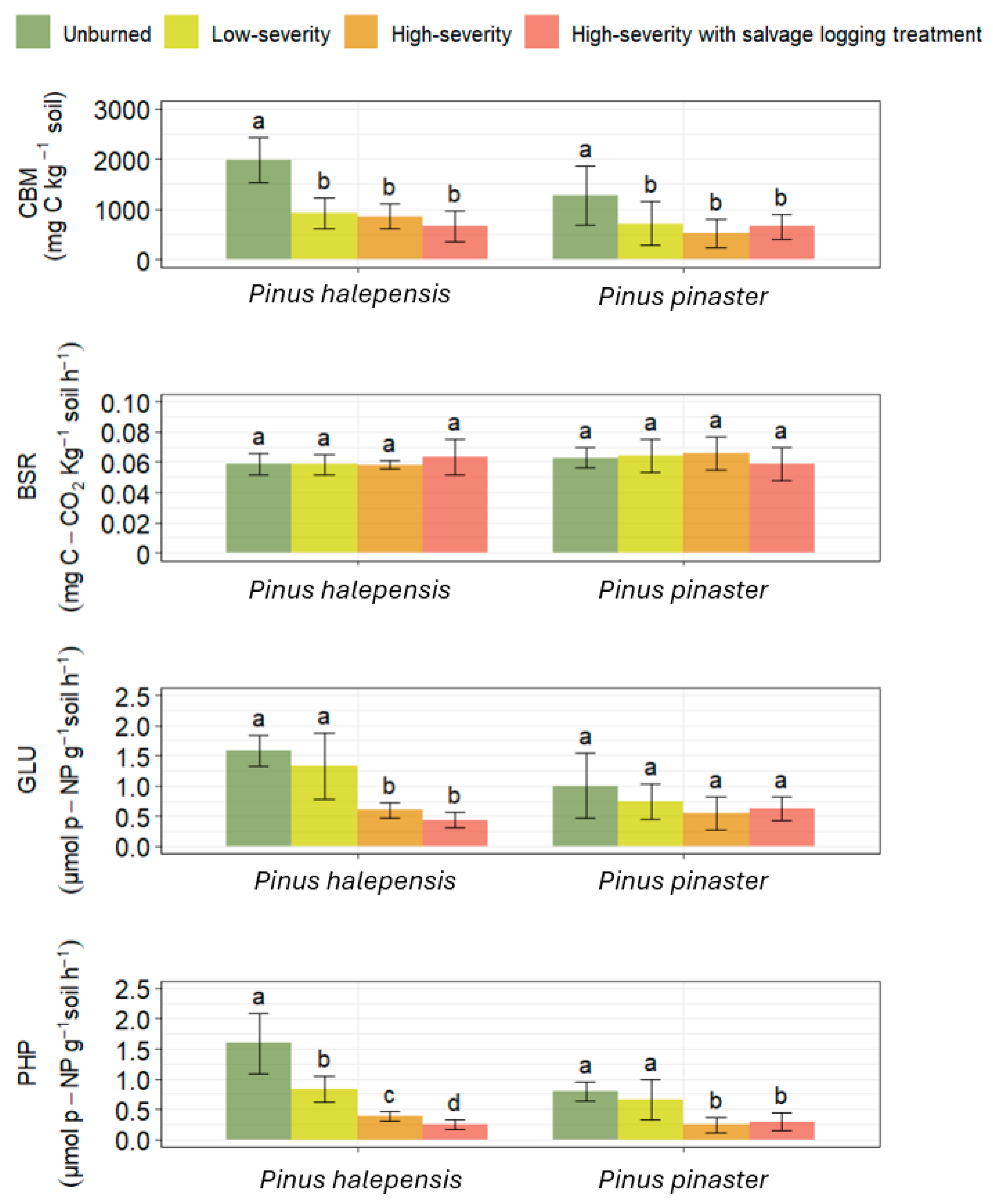
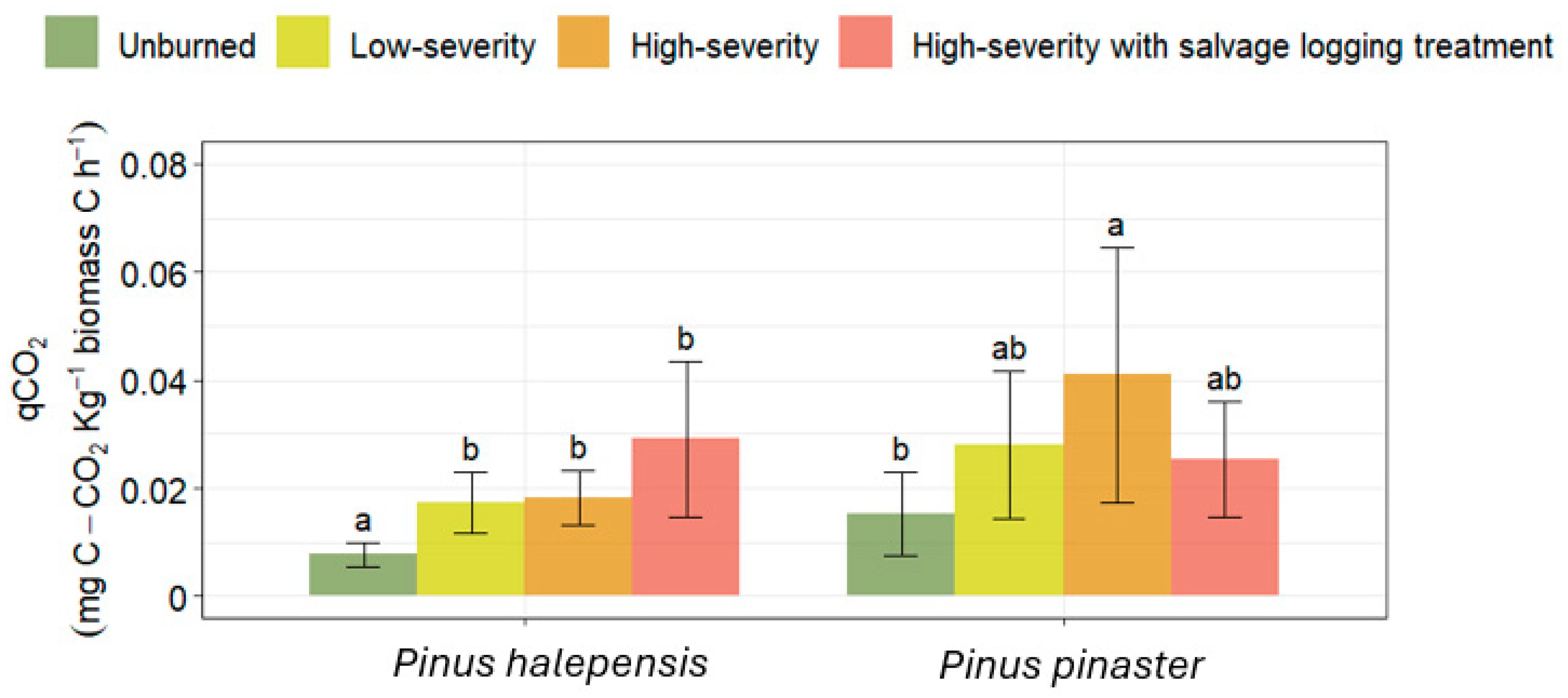

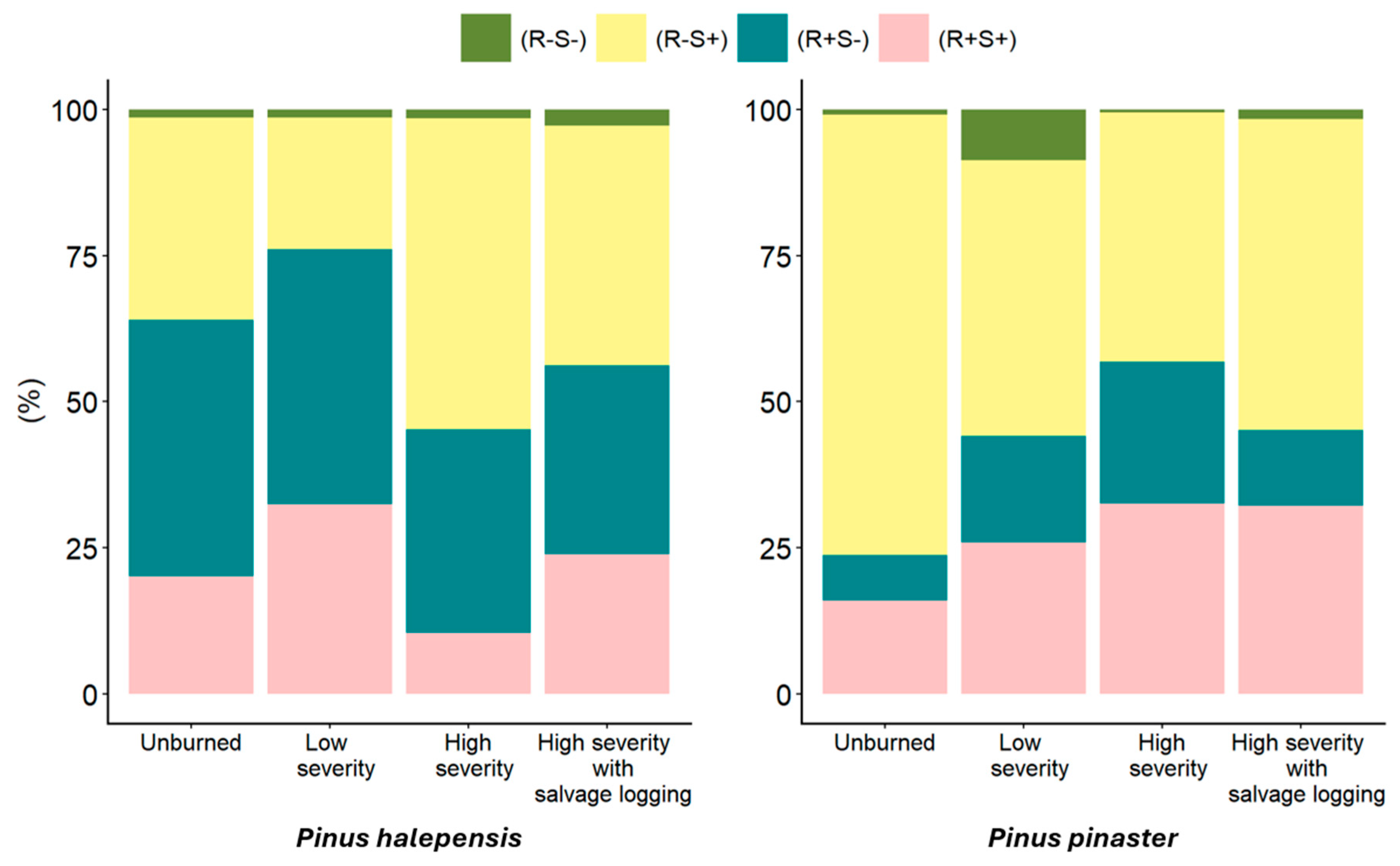

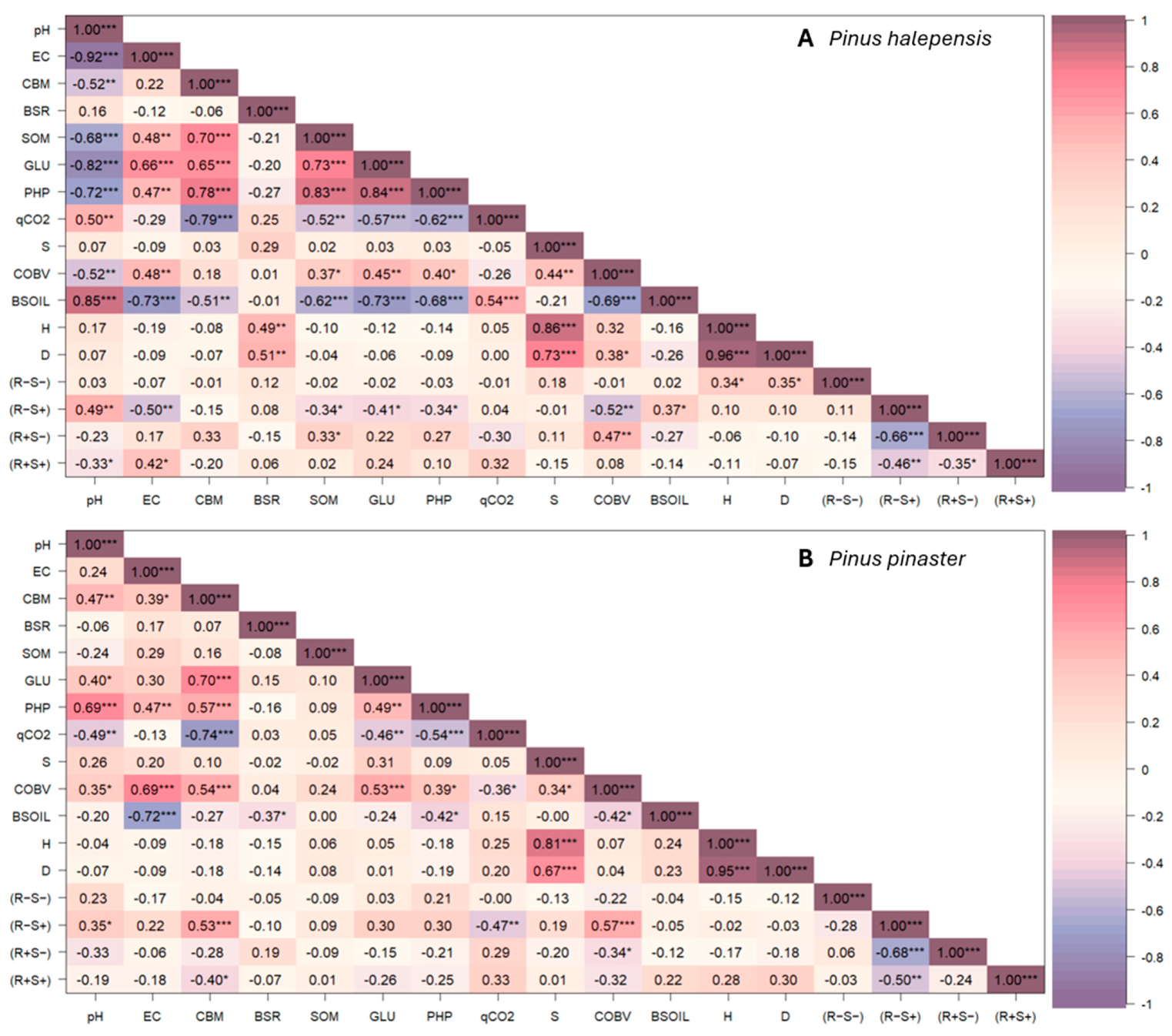
| SP | VAR | Unburned | Low-Severity | High-Severity | High-Severity with Salvage Logging Treatment | F | Pr (>F) |
|---|---|---|---|---|---|---|---|
| Pinus halepensis | pH | 8.07 ± 0.07 b | 8.04 ± 0.05 b | 8.2 ± 0.01 a | 8.28 ± 0.01 a | 14.540 | 0.013 |
| EC | 195.85 ± 7.28 a | 246.95 ± 82.05 a | 148.90 ± 4.94 a | 154.5 ± 34.64 a | 2.055 | 0.249 | |
| SOM | 10.09 ± 2.37 c | 7.24 ± 1.82 b | 4.17 ± 0.73 a | 5.24 ± 1.00 a | 28.520 | 0.000 | |
| Pinus pinaster | pH | 8.12 ± 0.15 a | 7.99 ± 0.08 a | 7.24 ± 0.94 a | 7.72 ± 0.31 a | 14.540 | 0.013 |
| EC | 174.35 ± 9.82 a | 118.05 ± 7.42 ab | 137.30 ± 34.64 ab | 71.00 ± 5.37 b | 2.055 | 0.249 | |
| SOM | 6.73 ± 1.37 ab | 4.79 ± 1.50 b | 7.26 ± 2.19 a | 5.50 ± 2.32 ab | 3.189 | 0.037 |
| SP | VAR | Unburned | Low-Severity | High-Severity | High-Severity with Salvage Logging Treatment | F | Pr (>F) |
|---|---|---|---|---|---|---|---|
| Pinus halepensis | COBV | 137.02 ± 41.73 a | 134.64 ± 50.41 a | 100.06 ± 34.49 ab | 88.13 ± 33.31 b | 4.951 | 0.006 |
| BSOIL | 0 ± 0 b | 3.60 ± 5.59 b | 35.42 ± 14.65 a | 39.55 ± 19.30 a | 35.730 | 0.000 | |
| S | 5.56 ± 1.19 a | 5.08 ± 1.17 a | 5.81 ± 1.80 a | 6.33 ± 2.61 a | 0.276 | 0.842 | |
| NSeed | 0 ± 0 b | 1 ± 1 b | 1 ± 1 b | 3 ± 2 a | 6.590 | 0.0009 | |
| Hm | 0 ± 0 b | 5.69 ± 3.23 b | 15.20 ± 8.69 a | 13.60 ± 5.84 a | 15.53 | 0.0000 | |
| Pinus pinaster | COBV | 214.2 ± 32.55 a | 77.78 ± 40.71 b | 104.02 ± 49.93 b | 73.09 ± 24.55 b | 11.480 | 0.000 |
| BSOIL | 0.79 ± 2.05 b | 0 ± 0 b | 13.59 ± 17.13 b | 44.01 ± 14.75 a | 35.760 | 0.000 | |
| S | 7.42 ± 1.25 a | 6.44 ± 2.57 a | 5.72 ± 2.03 a | 5.72 ± 1.42 a | 1.367 | 0.271 | |
| NSeed | 0 ± 0 a | 1 ± 1 a | 1 ± 1 a | 1 ± 1 a | 1.140 | 0.3430 | |
| Hm | 0 ± 0 c | 5.67 ± 7.16 bc | 16.20 ± 14.00 a | 15.10 ± 6.18 ab | 6.898 | 0.0007 |
| SP | VAR | Unburned | Low-Severity | High-Severity | High-Severity with Salvage Logging Treatment | F | Pr (>F) |
|---|---|---|---|---|---|---|---|
| Pinus halepensis | (R−S−) | 1.38 ± 2.56 a | 1.36 ± 1.70 a | 1.48 ± 4.54 a | 2.81 ± 4.58 a | 0.142 | 0.934 |
| (R−S+) | 34.60 ± 16.99 ab | 22.56 ± 13.78 b | 53.29 ± 21.48 a | 41.02 ± 17.86 ab | 3.955 | 0.0166 | |
| (R+S−) | 43.88 ± 18.70 a | 43.70 ± 17.40 a | 34.79 ± 23.18 a | 32.30 ± 16.21 a | 0.823 | 0.491 | |
| (R+S+) | 20.14 ± 16.46 ab | 32.38 ± 11.66 a | 10.44 ± 7.85 b | 23.87 ± 17.65 ab | 4.379 | 0.0108 | |
| Pinus pinaster | (R−S−) | 0.92 ± 1.43 b | 8.69 ± 8.00 a | 0.49 ± 1.10 b | 1.62 ± 3.88 b | 5.424 | 0.0039 |
| (R−S+) | 75.34 ± 9.99 a | 47.18 ± 19.52 b | 42.71 ± 21.11 b | 53.24 ± 19.25 b | 5.53 | 0.0036 | |
| (R+S−) | 7.79 ± 5.66 a | 18.29 ± 17.89 a | 24.21 ± 24.35 a | 12.99 ± 8.66 a | 2.29 | 0.0971 | |
| (R+S+) | 15.95 ± 10.49 a | 25.84 ± 13.34 a | 32.59 ± 20.45 a | 32.15 ± 19.07 a | 0.862 | 0.471 |
Disclaimer/Publisher’s Note: The statements, opinions and data contained in all publications are solely those of the individual author(s) and contributor(s) and not of MDPI and/or the editor(s). MDPI and/or the editor(s) disclaim responsibility for any injury to people or property resulting from any ideas, methods, instructions or products referred to in the content. |
© 2024 by the authors. Licensee MDPI, Basel, Switzerland. This article is an open access article distributed under the terms and conditions of the Creative Commons Attribution (CC BY) license (https://creativecommons.org/licenses/by/4.0/).
Share and Cite
Peña-Molina, E.; Moya, D.; Fajardo-Cantos, Á.; García-Orenes, F.; Mataix-Solera, J.; Arcenegui, V.; Lucas-Borja, M.E.; de las Heras, J. Burn Severity and Postfire Salvage Logging Effects on Vegetation and Soil System in a Short-Term Period in Mediterranean Pine Forests. Fire 2024, 7, 127. https://doi.org/10.3390/fire7040127
Peña-Molina E, Moya D, Fajardo-Cantos Á, García-Orenes F, Mataix-Solera J, Arcenegui V, Lucas-Borja ME, de las Heras J. Burn Severity and Postfire Salvage Logging Effects on Vegetation and Soil System in a Short-Term Period in Mediterranean Pine Forests. Fire. 2024; 7(4):127. https://doi.org/10.3390/fire7040127
Chicago/Turabian StylePeña-Molina, Esther, Daniel Moya, Álvaro Fajardo-Cantos, Fuensanta García-Orenes, Jorge Mataix-Solera, Victoria Arcenegui, Manuel Esteban Lucas-Borja, and Jorge de las Heras. 2024. "Burn Severity and Postfire Salvage Logging Effects on Vegetation and Soil System in a Short-Term Period in Mediterranean Pine Forests" Fire 7, no. 4: 127. https://doi.org/10.3390/fire7040127








